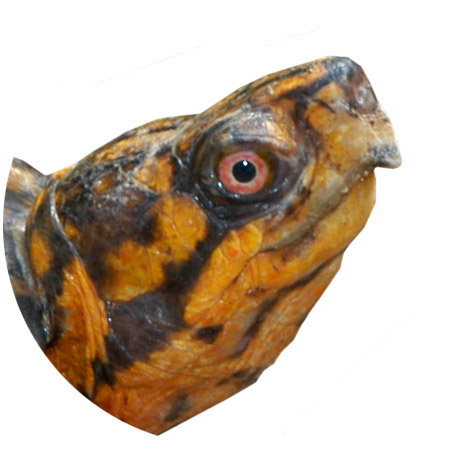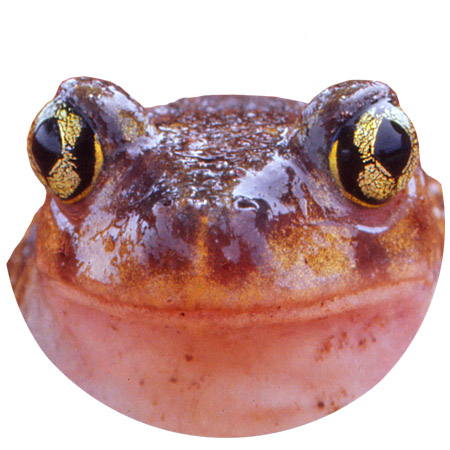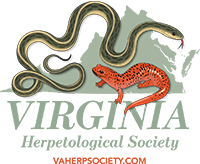Eastern Mud Salamander
Pseudotriton montanus montanus
Common Name: |
Eastern Mud Salamander |
Scientific Name: |
Pseudotriton montanus montanus |
Etymology: |
|
Genus: |
pseudes is Greek for "false" and triton is the Greek sea god. |
Species: |
montanus is Latin meaning "belonging to a mountain". |
Subspecies: |
montanus is Latin meaning "belonging to a mountain". |
Average Length: |
3 - 6.5 in. (7.5 - 16.5 cm) |
Virginia Record Length: |
|
Record length: |
8.1 in. (20.7 cm) |
Virginia Wildlife Action Plan Rating Tier IV (Moderate Conservation Need) - The species may be rare in parts of its range, particularly on the periphery. Populations of these species have demonstrated a significant declining trend or one is suspected which, if continued, is likely to qualify this species for a higher tier in the foreseeable future. Long-term planning is necessary to stabilize or increase populations.
Physical Description - The ground color above is dull, light to dark chocolate brown. The dorsal and lateral dark spots are usually distinct, sometimes obscure in old individuals, and when present extend well onto the lower sides. The venter has at least a few, often many, small, brown, widely separated dots. The iris of the eye is dark brown. They have a length up to 178 mm.
Historical versus Current Distribution - Mud Salamanders (Pseudotriton montanus) are found from extreme southeastern Louisiana east to the Atlantic Coast, north to southern New Jersey, and westward to the Illinois boundary (Martoff, 1975b). Four subspecies are currently identified: Eastern Mud Salamanders (P. m. montanus), Midland Mud Salamanders (P. m. diasticus), Gulf Coast Mud Salamanders (P. m. flavissimus), and Rusty Mud Salamanders (P.m. floridanus). Mud Salamanders are naturally absent from the higher elevations of the Appalachian Mountains and the northern coast of North Carolina. Mud Salamanders are reported from only two counties in New Jersey where they are listed as Threatened. Heckscher (1995) confirmed records for Sussex County, Delaware, where they were previously unreported. Miller (1990) verified their presence in Wilson County, Tennessee (see also Redmond and Scott, 1996). Mud Salamanders are listed as Endangered in Pennsylvania after being verified in Franklin County in 1991 (McCoy, 1992). Bruce (1974) reported the loss of habitat in Oconee, South Carolina, due to the impoundment of the Little River to form Lake Keowee.
Historical versus Current Abundance - Little is known about the abundance of this secretive, often subterranean species. It is not uncommon for decades to pass between sightings despite intense collection efforts at a given location. Many of the written accounts are based on observations of a single specimen or few individuals (Wright and Trapido, 1940; Fowler, 1946; Barbour, 1953; Hirschfield and Collins, 1963; Miller, 1990; Heckscher, 1995). The scarcity of records for the Delmarva Peninsula has been attributed in part to the secretive nature of mud salamanders, although wetland loss and degradation are believed to have impacted this species (Heckscher, 1995). Mount (1975) reported a lack of abundance of specimens from known localities in Alabama. Mud Salamanders were found in Louisiana in 1998 after a 31-yr absence of records (J. Boundy, personal communication). Mud Salamanders were first described by Baird based on a specimen from South Mountain in Cumberland County, Pennsylvania. This was long believed to be a questionable account (McCoy, 1982), as repeated searching at this locality failed to locate mud salamanders. However, McCoy (1992) confirmed the species in neighboring Franklin County after an absence of records spanning approximately 140 yr.
Breeding - Reproduction is aquatic.
Breeding migrations - There is no known breeding migration for this predominately aquatic and fossorial species. Mating has been reported in September in Kentucky (Robinson and Riechard, 1965). Mature sperm, indicative of the reproductive peak, were found in the vas deferens of adult males in South Carolina from mid August to mid September (Bruce, 1975). Adult males and females are often found together in the same burrow during this time.
Breeding habitat - Springs, seeps, and bogs (Brimley, 1939; Fowler, 1946; Goin, 1947c).
Egg deposition sites - Bruce (1975) estimated oviposition to occur in November based on reports in the literature. Sexually mature females were gravid from mid August to mid September (Bruce, 1975). Fowler (1946) found eggs in various stages of development in late December.
Little data on breeding habitats exist for Mud Salamanders. Brimley (1939) reported egg masses attached to dead leaves in a small spring in North Carolina. Fowler (1946) found egg clusters in the rootlets of a hillside seep near a cypress swamp in Maryland. Goin (1947c) reported eggs in a boggy, sphagnum seepage. Eggs were gathered in clusters ranging from 2–8 ova and attached to rootlets that hung down into the water on the edge of an undercut bank.
Clutch size - Dissection of the ovaries of mature females revealed 77–192 yolked oocytes, increasing in number as a function of body volume, for populations in South Carolina (Bruce, 1975). However, clutches exceeding 30 eggs have not been found.
Altig & McDiarmid 2015 - Classification and Description:
- Eastern Array 1 - Oviposited as small arrays of a few eggs, 120 mm or less diameter, in springs, streams, and caves.
- Arrangement 1 - Eggs deposited in cobble or under rocks in springs and streams or among debris and vegetation ay lowland sites. At lowland site the array structure may not be apparent. Ova pigmented.
- Sub-arrangement A - Egg diameter 6.0mm or greater. Single jelly layer in pedicel.
- Arrangement 1 - Eggs deposited in cobble or under rocks in springs and streams or among debris and vegetation ay lowland sites. At lowland site the array structure may not be apparent. Ova pigmented.
Goin (1947c) reported recently hatched larvae on 14 January and 22 February in Florida. Hatching has been estimated to occur in February to early March in the Carolinas (Bruce, 1978b), with hatchlings ranging from 7.5–9.0 mm SVL (Goin, 1947c) to 10–13 mm (Bruce, 1974, 1978b).
Length of larval stage - Development from ovipositing to metamorphosis can be as quick as 1.5 yr or last as long as 2.5 yr, and may be a consequence of differences in temperature (Bruce, 1978b). Size at metamorphosis is consistent, with a SVL ranging from 36–48 mm, with a mean near 40 mm (Bruce, 1978b [It should be noted that Bruce (1978b) measured SVL to the anterior edge of the cloaca, not to the posterior edge, which is the currently accepted method.]). Goin (1947c) reported larvae ranging from 34–39 mm SVL in January. Netting and Goin (1942b) found transformed larvae ranging from 38–43 mm SVL with a total length of about 74 mm. Metamorphosis may occur from May–September.
Larvae Food - Larvae presumably feed on a variety of aquatic invertebrates.
Cover - Bruce (1974) found larvae in the mud and decaying vegetation of springs, small streams, and swampy pools and ponds; Bruce (2003) found Mud Salamanders in the bottomland swamp of a third order stream.
Larval polymorphisms - Unknown.
Time to metamorphosis - From 1.5–2.5 yr after ovipositing. Bruce's (1974) data for South Carolina populations suggest that metamorphosis occurs over a lengthy period, from mid May to early September, with a concentration in July–August.
Post-metamorphic migrations - Bruce (1975) found recently transformed larvae along the margin of watercourses in the leaves and debris and observed movements through a series of burrows that connect their watercourse to upland habitats.
Neoteny - Unknown.
Juvenile Habitat - Recently transformed individuals do not burrow as readily as older adults, but are found in leaves and debris at the edge of the water (Bruce, 1975).
Adult Habitat - Contrary to what the species name montanus might imply, Mud Salamanders are predominantly a lowland species (Wright and Trapido, 1940; Bruce, 1975; Heckscher, 1995). The preferred habitat has been described as consisting of lowland seeps, palustrine wetlands, muddy springs and streams, and swampy pools and ponds. Bruce (1975) reported the use of complexes of burrows concentrated near the water, but occasionally being located as far as 15–20 m away from surface water. These contained vertical channels to the surface from the water table below. Adults were located in the burrows with their heads near the surface. Laboratory observations revealed that individuals will construct their own burrows, rather than use those abandoned by other species (Bruce, 1975). Mount (1975) reported finding Mud Salamanders beneath logs in low, wooded flood plains. Funderburg (1955) observed that “it is a subterranean form and is seldom found under old logs as it is in other localities” in North Carolina. Barbour (1953) found a female under a stone in a dry, rocky pasture during August in Kentucky.
Home Range Size - Unknown.
Territories - Unknown.
Aestivation/Avoiding Dessication - Undocumented.
Seasonal Migrations - Limited migrations away from the breeding habitat occur during the summer.
Torpor (Hibernation) - Does not occur; Mud Salamanders are active throughout the year.
Interspecific Associations/Exclusions - Found in association with Spring Salamanders (Gyrinophilus porphyriticus), Two-lined Salamanders (Eurycea bislineata), Long-tailed Salamanders (E. longicauda), red Salamanders (Pseudotriton ruber), Northern Dusky Salamanders (Desmognathus fuscus), Four-toed Salamanders (Hemidactylium scutatum), and Eastern Newts (Notophthalmus viridescens). Along the Coastal Plain of South Carolina they are found in association with Southern Dusky Salamanders (D. auriculatus), Long-tailed Salamanders, Two-lined Salamanders, Lesser Sirens (Siren intermedia), and Two-toed Amphiumas (Amphiuma means; Semlitsch, 1983d).
Age/Size at Reproductive Maturity - Females reach sexual maturity at 4–5 yr of age (Bruce, 1975). Males reach sexual maturity in the first year following metamorphosis at a size exceeding 43 mm SVL, reproducing for the first time in the second, third, or fourth year of life, depending on the duration of the larval stage (Bruce, 1975).
Longevity - In captivity, individuals have lived past 15 yr (Snider and Bowler, 1992).
Feeding Behavior - Quantitative data are lacking on this aspect of the life history of the mud salamander. Dunn (1926) believed that adults may prey on smaller salamanders.
Predators - Snakes are the only documented predators of Mud Salamanders. Water snakes (Nerodia sipedon) feed on larval Mud Salamanders (E.E. Brown, 1979; Kats, 1986). Garter snakes (Thamnophis sirtalis) were reported as predators of adult Mud Salamanders by Carr (1940a) and E.E. Brown (1979).
Anti-Predator Mechanisms - Defensive posturing includes extending the rear limbs, curling the body, and raising the tail or wrapping it around the head. A toxic substance is secreted along the back. Mud Salamanders are currently believed to be part of a Mullerian mimicry complex with Eastern Newts (Notophthalmus viridescens) and Spring Salamanders (Gyrinophilus porphyriticus).
Diseases - Unknown.
Parasites - Rankin (1937) described the parasites of Mud Salamanders from North Carolina as follows: Protozoa—Haptophrya michiganensis, Prowazekella longifilis, and Tritrichomonas augusta; Trematoda—Allocreadium pseudotritoni, and Gorgoderina bilobata; Nematoda—Physaloptera sp.; Acarina—Hannemania dunni.
Conservation - Mud Salamander populations have been lost (Bruce, 1974). They are listed as Rare and on the Watchlist in Maryland, as a Species of Special Concern in Louisiana and South Carolina, and are limited in range and considerd Rare in Ohio (Pfingsten, 1989f) and West Virginia. They are listed as Threatened in New Jersey (Levell, 1997), and as Endangered in Pennsylvania, after being verified in Franklin County in 1991 (McCoy, 1992).
References for Life History
- Altig, Ronald & McDiarmid, Roy W. 2015. Handbook of Larval Amphibians of the United States and Canada. Cornell University Press, Ithaca, NY. 341 pages.
- AmphibiaWeb. 2020. University of California, Berkeley, CA, USA.
- Bishop, S.C., 1943, Handbook of Salamanders, 555 pgs., Comstock Publ. Co., New York, NY
- Martof, B.S., Palmer, W.M., Bailey, J.R., Harrison, III J.R., 1980, Amphibians and Reptiles of the Carolinas and Virginia, 264 pgs., UNC Press, Chapel Hill, NC
Photos:
*Click on a thumbnail for a larger version.
Verified County/City Occurrence
Amelia
Augusta
Caroline
Charles City
Chesterfield
Fairfax
Floyd
Franklin
Gloucester
Goochland
Greene
Hanover
Henrico
Henry
James City
King and Queen
King George
King William
Lancaster
Mecklenburg
Middlesex
New Kent
Nottoway
Pittsylvania
Prince William
Richmond
Stafford
Surry
Sussex
Westmoreland
York
CITIES
Alexandria
Hopewell
Newport News
Suffolk
Verified in 31 counties and 4 cities.
 larvae12_small.jpg)



